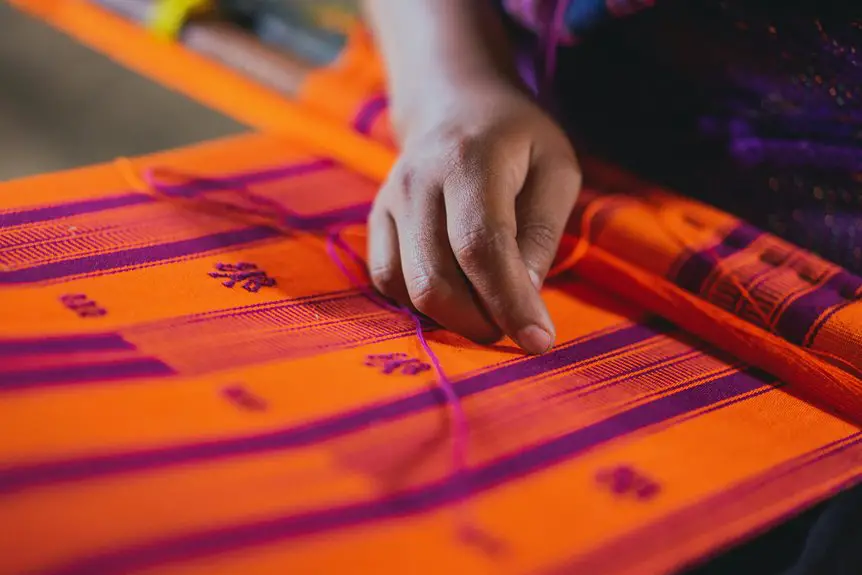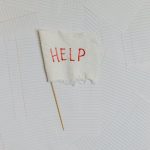Devoré velvet is a fabric technique that uses a chemical burnout process to create intricate, semi-transparent patterns by dissolving certain fibers, usually cotton, while leaving others like silk intact. You’ll find it in elegant floral, geometric, and abstract designs that blend rich texture with sheer areas for a striking look. This method originated in early 20th-century Europe and adds depth to both fashion and interior decor. Explore further to uncover its history, science, and stylish uses.
Table of Contents
Key Takeaways
- Devoré velvet is a fabric with patterns created by selectively burning away fibers using a chemical burnout technique.
- The burnout process dissolves cellulose fibers, revealing sheer and solid contrasts that form intricate designs.
- It typically uses fiber blends like cotton and silk, where cotton burns away and silk remains textured.
- Popular patterns include floral, geometric, nature-inspired, and abstract designs emphasizing texture and transparency.
- Devoré velvet is used in fashion for elegant garments and in interiors to add artistic flair with dynamic visual effects.
Origins and History of Devoré Velvet
Although you mightn’t realize it, devoré velvet has a rich history that dates back to the early 20th century.
You’ll find that this fabric originated in Europe, particularly in France and England, where textile innovators sought new ways to create intricate patterns on luxurious materials.
When you explore devoré, you’re tapping into a tradition that blends artistry with textile craft.
Designers quickly embraced devoré velvet for its unique ability to combine sheer and plush textures in one piece.
As you wear or work with devoré velvet, you engage with a fabric that has evolved alongside fashion trends while maintaining its distinctive elegance.
This history not only adds value but also deepens your appreciation for the fabric’s timeless appeal and craftsmanship.
The Science Behind the Burnout Technique
When you examine the burnout technique behind devoré velvet, you’ll discover a fascinating chemical process that selectively dissolves fibers to create intricate patterns.
The process involves applying a gel containing acids or oxidizing agents onto the fabric’s surface. These chemicals target specific fibers, usually cellulose-based, breaking down their structure without affecting the synthetic or protein fibers.
This selective dissolution removes parts of the fabric, leaving sheer, textured designs where fibers once were. You control the pattern by carefully applying the chemical gel in desired motifs, allowing for precise artistry.
After the gel works its magic, the fabric is washed to remove residue, revealing the elegant contrast between sheer and solid areas. This science-driven method makes devoré velvet unique and visually striking.
Materials and Fabrics Used in Devoré
Understanding the chemical process behind devoré velvet helps you appreciate why the choice of materials matters so much. Devoré relies on blending fibers—usually a cellulose-based fabric and a synthetic or animal fiber—that react differently to the chemical burnout. You’ll often find silk and cotton blends because cotton burns away, leaving silk’s texture intact.
Here’s a quick look at common fabric combos:
| Fiber 1 | Fiber 2 | Resulting Texture |
|---|---|---|
| Cotton | Silk | Soft, sheer patterns |
| Rayon | Polyester | Smooth with contrast |
| Viscose | Nylon | Delicate, raised look |
Popular Patterns and Design Inspirations
Because devoré velvet combines texture and transparency, it lends itself beautifully to intricate and bold patterns that catch the eye.
Devoré velvet’s blend of texture and transparency creates stunning, eye-catching patterns full of depth and intrigue.
You’ll often see floral motifs, where delicate blooms contrast with sheer backgrounds, creating a romantic yet modern look. Geometric shapes also play a big role, offering sharp lines and symmetry that highlight the fabric’s unique burnout effect.
Nature-inspired designs, such as leaves and vines, bring an organic elegance, while abstract patterns push the boundaries of traditional aesthetics.
When choosing devoré velvet, you can expect these patterns to emphasize depth and dimension, giving your pieces a striking visual appeal.
Applications in Fashion and Interior Design
Although devoré velvet stands out for its visual appeal, its versatility truly shines in both fashion and interior design.
When you wear devoré velvet, you embrace a fabric that combines luxury with texture, perfect for evening gowns, blouses, and scarves that catch the light and impress with subtle patterns. Designers often use it to add depth and elegance without overwhelming the silhouette.
In your living space, devoré velvet elevates upholstery, curtains, and cushions, lending a sophisticated touch that balances softness with intricate detailing.
Its semi-transparent areas create a dynamic effect, making rooms feel both cozy and visually interesting. Whether you’re dressing up or decorating, devoré velvet offers you an artistic flair that blends classic charm with modern style effortlessly.
Caring for and Maintaining Devoré Velvet Garments
To keep your devoré velvet garments looking their best, you’ll need to follow specific cleaning methods that protect the delicate fabric.
Proper storage is also essential to prevent crushing and maintain the texture.
Let’s explore the best ways to clean and store these luxurious pieces.
Cleaning Methods
When you care for devoré velvet garments properly, you’ll preserve their unique texture and delicate patterns. Cleaning these pieces requires gentle handling to avoid damage.
Here’s how you can keep your devoré velvet looking its best:
- Spot clean with a mild detergent and cold water immediately if stains occur.
- Hand wash gently in cold water, avoiding wringing or twisting the fabric.
- Use a mesh laundry bag if machine washing is necessary on a delicate cycle.
- Air dry flat away from direct sunlight to maintain the fabric’s integrity and prevent fading.
Avoid bleach or harsh chemicals, as they can ruin the burnout patterns.
Following these steps will keep your devoré velvet vibrant and soft.
Storage Tips
Properly storing your devoré velvet garments is essential to preserving their delicate burnout patterns and luxurious texture.
Always hang them on padded hangers to prevent creases and maintain shape. Avoid wire hangers, as they can distort the fabric.
If you must fold your pieces, place acid-free tissue paper between folds to reduce pressure and prevent permanent marks.
Store your devoré velvet in a cool, dry place away from direct sunlight, which can fade colors and weaken fibers.
Use breathable garment bags rather than plastic ones to allow air circulation and avoid moisture buildup.
Finally, keep your garments away from rough surfaces and sharp objects to prevent snags and damage.
Following these steps will help your devoré velvet stay beautiful and lasting longer.
Frequently Asked Questions
Can Devoré Velvet Be Dyed After the Burnout Process?
About 70% of devoré velvet retains enough fiber post-burnout to accept dye. You can dye it after the burnout process, but colors might appear uneven due to the mix of sheer and textured areas created by the technique.
Is Devoré Velvet Environmentally Friendly or Sustainable?
You might find devoré velvet isn’t very sustainable since it involves chemical processes and energy use. If you want eco-friendly options, look for natural fibers and low-impact dyes instead of devoré’s burnout technique.
How Long Does the Devoré Burnout Process Take?
You won’t believe how quick the devoré burnout process is—it typically takes just a few hours! While it sounds like an eternity of delicate work, artists actually finish it pretty swiftly, preserving fabric’s beauty.
Can Devoré Velvet Be Used for Upholstery on Outdoor Furniture?
You shouldn’t use devoré velvet for outdoor furniture upholstery because it’s delicate and not weather-resistant. It can easily get damaged by moisture, sunlight, and wear, so stick to more durable, outdoor-specific fabrics instead.
Are There Any Health Risks When Working With Devoré Chemicals?
You should handle devoré chemicals carefully since they can irritate your skin, eyes, and lungs. Always wear gloves, work in a well-ventilated area, and use protective gear to minimize health risks when working with these substances.
- The History and Evolution of Chamois Fabric - June 22, 2025
- Chamois Fabric on Wikipedia: What You Need to Know - June 22, 2025
- How to Pronounce Chamois Fabric Correctly - June 22, 2025






